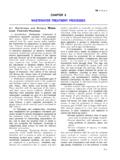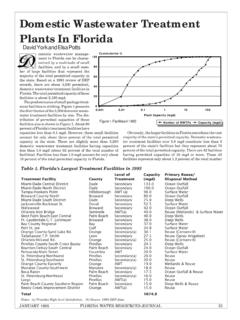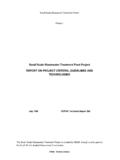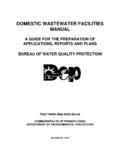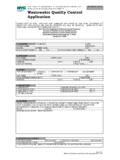Transcription of Application of treatment and disposal methods 9 ...
1 Application of treatment and disposal methods1139 Application of treatment anddisposal methods tohealth-care waste categoriesSuitable treatment and disposal methods for the different categories ofhealth-care waste are summarized in Table and discussed in moredetail in this Infectious waste and sharpsWithin the limitations mentioned in the relevant sections, almost all thetreatment methods outlined in Chapter 8 are suitable for infectiouswaste and sharps, except inertization. The treatment option should bechosen according to the national and local infectious microorganisms by heat, by chemical means, orby microwave irradiation is relatively easy. Highly infectious waste,such as cultures and stocks of infectious agents from laboratory work,should be sterilized by wet thermal treatment ( autoclaving) at theearliest stage possible.
2 For other infectious health-care waste, disinfec-tion is should undergo incineration whenever possible, and can be incin-erated together with other infectious waste. Encapsulation is also suit-able for sharps. After incineration or other disinfection, the residues maybe exceptional emergency situations, such as outbreaks of communicablediseases, burning of infectious health-care waste in open trenches mayalso be envisaged if it is not possible to use any of the treatment optionsdescribed in Chapter 8 (see also Chapter 16).Unless there is an adequate wastewater treatment plant, blood should bedisinfected before discharge to a sewer; it may also be Pharmaceutical wasteSound management of pharmaceutical products facilitates waste mini-mization (see section ) and is of prime importance to better wastemanagement in general.
3 disposal of small amounts of chemical or phar-maceutical waste is easy and relatively cheap; large amounts require theuse of special treatment disposal of small quantities of pharmaceutical wasteThe disposal options for small quantities of pharmaceutical waste in-clude those outlined in the following management of wastes from health-care activities114 Landfill disposalSmall quantities of pharmaceutical waste produced on a daily basismay be landfilled provided that they are dispersed in large quantitiesof general waste. Cytotoxic and narcotic drugs, however, should neverbe landfilled, even in small quantities. EncapsulationSmall quantities of pharmaceutical waste may be encapsulated, to-gether with sharps if appropriate.
4 Safe burial on hospital premisesSafe burial of small quantities of pharmaceutical waste prevents scav-enging and may be an appropriate disposal method for establishmentsapplying minimal programmes. Discharge to a sewerModerate quantities of relatively mild liquid or semi-liquid pharma-ceuticals, such as solutions containing vitamins, cough syrups, intra-venous solutions, eye drops, etc. (but not antibiotics or cytotoxic drugs),may be diluted in a large flow of water and discharged into municipalsewers. It is not acceptable, however, to discharge even small quanti-Table of disposal and treatment methods suitable for differ-ent categories of health-care wasteTechnology or methodInfectiousAnatomicalSharpsPharmace uticalCytotoxicChemicalRadioactivewastew astewastewastewastewasteRotary kilnYesYesYesYesYesYesLow-levelinfectiou swastePyrolytic incineratorYesYesYesSmallNoSmallLow-leve lquantitiesquantitiesinfectiouswasteSing le-chamberYesYesYesNoNoNoLow-levelincine ratorinfectiouswasteDrum or brickYesYesYesNoNoNoNoincineratorChemica l disinfectionYesNoYesNoNoNoNoWet thermal treatmentYesNoYesNoNoNoNoMicrowave irradiationYesNoYesNoNoNoNoEncapsulation NoNoYesYesSmallSmallNoquantitiesquantiti esSafe burial on
5 HospitalYesYesYesSmallNoSmallNopremisesq uantitiesquantitiesSanitary landfillYesNoNoSmallNoNoNoquantitiesDisc harge to sewerNoNoNoSmallNoNoLow-levelquantitiesl iquidwasteInertizationNoNoNoYesYesNoNoOt her methodsReturn expiredReturn expiredReturn unusedDecay bydrugs todrugs tochemicals tostoragesuppliersuppliersupplierApplica tion of treatment and disposal methods115ties of pharmaceutical waste into slow-moving or stagnant waterbodies. IncinerationSmall quantities of pharmaceutical waste may be incinerated togetherwith infectious or general waste, provided that they do not form morethan 1% of the total waste (in order to limit potentially toxic emissionsto the air). disposal of large quantities of pharmaceutical wasteLarge quantities of solid pharmaceutical waste may have to be dealt withif a pharmacy closes down, for example, or after emergencies (see alsoGuidelines for safe disposal of unwanted pharmaceuticals in emergenciesand difficult circumstances1).
6 The treatment methods outlined in thefollowing paragraphs are suitable. IncinerationIncineration is the best way to dispose of pharmaceutical waste. Thewastes should be mixed with their cardboard packaging, and possiblywith other combustible material and infectious waste, to ensure opti-mal combustion conditions. Low-temperature incineration (<800 C),however, provides only limited treatment for this type of waste; it isnot recommended unless it is followed by combustion in a secondchamber, operating at temperatures about 1000 C, to burn off poten-tially toxic exhaust gases that may be produced. Ideally, largeamounts of pharmaceuticals should be treated in incinerators de-signed for industrial waste (including rotary kilns), which can operateat high temperatures (>1200 C).
7 Cement kilns are also particularlysuited to the treatment of pharmaceuticals; in many countries, cementproducers accept pharmaceutical waste as an alternative fuel, thusreducing fuel costs. As a rule of thumb , however, it is suggested thatno more than 5% of the fuel fed into the furnace at any time ispharmaceutical material. EncapsulationSolid, liquid, and semi-liquid waste can be encapsulated in metaldrums (see section ).Landfilling of large quantities of pharmaceuticals is not recommendedunless the waste is encapsulated and disposed of in sanitary landfillsites, where the risk of groundwater contamination is minimized. Largeamounts of pharmaceutical waste should not be disposed of with generalhospital waste, nor should they be diluted and discharged into sewers(except for certain very mild solutions, such as vitamin preparations).
8 Intravenous fluids and glass ampoules are special cases. Intravenousfluids (salts, amino acids, lipids, glucose, etc.), which are relatively harm-less, can be disposed of to a landfill or discharged into a sewer. Ampoulesshould be crushed on a hard, impermeable surface; workers should wearprotective clothing, eye protection, gloves, etc. The glass should then be1 disposal of unwanted pharmaceuticals in emergencies and difficult , World Health Organization (unpublished document, in preparation; will beavailable on request from Department of Essential Drugs and other Medicines, WorldHealth Organization, 1211 Geneva 27, Switzerland).Safe management of wastes from health-care activities116swept up, collected, and disposed of with sharps.
9 Ampoules should not beincinerated as they may explode, damaging the incinerator or Cytotoxic wasteCytotoxic waste is highly hazardous and should never be landfilled ordischarged into the sewerage system. disposal options include thefollowing: Return to original supplierSafely packaged but outdated drugs and drugs that are no longerneeded should be returned to the supplier. This is currently the pre-ferred option for countries that lack the facilities for that have been unpacked should be repackaged in a manner assimilar as possible to the original packaging and marked outdated or not for use . Incineration at high temperaturesFull destruction of all cytotoxic substances may require temperaturesup to 1200 C; Table gives the minimum temperatures necessary todestroy common cytotoxic products.
10 Incineration at lower tempera-tures may result in the release of hazardous cytotoxic vapours into double-chamber pyrolytic incinerators are suitable, providedthat a temperature of 1200 C with a minimum gas residence time of2 seconds or 1000 C with a minimum gas residence time of 5 secondscan be achieved in the second chamber. The incinerator should beTable temperatures for destruction of cytotoxic drugs, forconventional residence times, according to different authorsCompoundTemperatureCompoundTemper atureAclarubicin1000 CaEtoposide1000 Cb, 700 CaAmsacrine>260 Ca, 260 Cb5-Fluorouracil1200 Cc, 1000 Cb, 700 CaBleomycin1000 CaIdarubicin700 CaCarboplatin1000 CaIfosfamide1000 CaCarmustine1000 Ca,bMelphalan500 CaChlormethine (mustine)










